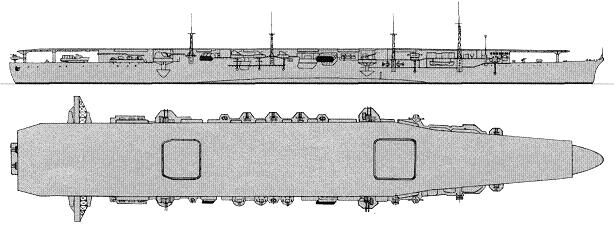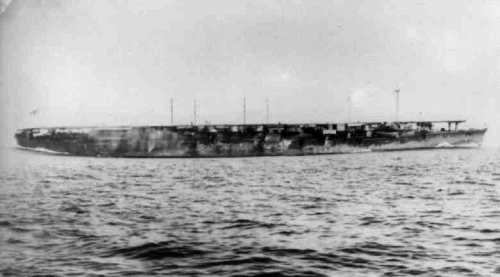
NAVYPEDIA
 Support the project with paypal
Support the project with paypal
Photo

Chitose 1938
Ships
| Name | No | Yard No | Builder | Laid down | Launched | Comp | Fate |
|---|---|---|---|---|---|---|---|
| 千歳 [Chitose] | Kure K K | 26.11.1934 | 29.11.1936 | 25.7.1938 | converted to carrier from 1.1943 | ||
| 千代田 [Chiyoda] | Kure K K | 14.12.1936 | 19.11.1937 | 15.12.1938 | converted to carrier from 8.1942 |
Technical data
| Data variant | as seaplane tenders | as aircraft carriers |
|---|---|---|
| Displacement standard, t | 11023 | 11190 |
| Displacement full, t | 12550 | 15300 |
| Length, m | 174.0 pp 183.9 wl 192.5 oa |
174.0 pp 185.9 wl 192.5 oa |
| Breadth, m | 18.8 |
20.8 wl 23.0 fd |
| Draught, m | 7.21 |
7.51 |
| No of shafts | 2 | 2 |
| Machinery | 2 sets Kampon geared steam turbines, 4 Kampon boilers + 2 Kampon diesels | 2 sets Kampon geared steam turbines, 4 Kampon boilers + 2 Kampon diesels |
| Power, h. p. | 44000 + 12800 |
44000 + 12800 |
| Max speed, kts | 29 / 18 |
28.9 |
| Fuel, t | oil 1000 | oil + diesel oil 3000 |
| Endurance, nm(kts) | 11000(18) |
11000(18) |
| Armour, mm | --- | deck: 70 - 20 |
| Armament | 2 x 2 - 127/40 89-shiki, 6 x 2 - 25/60 96-shiki, 24 seaplanes (E4N, E7K, E8N, E10A, E11A) |
4 x 2 - 127/40 89-shiki, 10 x 3 - 25/60 96-shiki, 30 aircraft (A6M fighters, D3A, D4Y diving bombers, B5N, B6N torpedo bombers) |
| Complement | 800 |
Air group
| Year | Fighters | torpedo bombers |
|---|---|---|
| 2.1944 | 15 A6M2, 6 A6M5 | 9 B5N |
| 10.1944 | 6 A6M2, 6 A6M5 | --- |
Standard scale images

Chiyoda 1941

Chitose 1941

Chitose 1944
Graphics
Aircraft facilities
There were 4 catapults. Seaplanes based on deck and in hangar. There were 2 lifts. 5 additional seaplanes carried as reserve. Aircraft fuel stowage was 900t.
Aircraft facilities after modernization(fd - 4,140m², ha ? m² / ? m³): Flight deck: 180.0x23.0m. There was hangar. There were fore (13.0x12.0m) and aft (12.5x12.0m) lifts. Aircraft fuel stowage: 900t.
Project history
The first Japanese purpose built seaplane tenders, built under 1st Supplementary Programme of 1931. Interesting feature of these ships was mixed diesel-turbine machinery, ensured the big endurance. Boiler room and No1 engine room (turbines) have been moved fwd, and engine room No2 (diesels) placed more close to stern. Boiler smoke ducts were pooled into one funnel. Diesels were connected with shafts by hydraulic clutches. Astern from engine room No1 in the hull extensive hangar has been arranged.
All upper deck astern from funnel has been assigned for placing of aircraft equipment. Aside there were four turning catapults grouped on two in fore and astern from mid-span. The space between catapults has been covered by hinged platform, leaning on four massive masts. Cargo booms were fastened to latter, and aft pair contained diesels smoke ducts. Between the second pair of catapults there was an elevator for handling of aircrafts stored in hangar astern from ER No2. Second elevator placed between pylons of a hinged platform. 5 more aircrafts were stored in the taken apart kind.
After loss of four carriers in battle at Midway it has been decided to rebuilt Chitose and Chiyoda as light carriers. A task was simplified that at a phase of working out of their project possibility of conversion of ships to rigorous carriers was provided. Conversion project basically repeated Zuiho and Ryuho, but did not provide replacement of machinery. Ships have equipped with a flush flight deck. For raise of stability and strengthening of underwater protection the hull was equipped with bulges which have increased hull breadth on 2m. Feature of architecture of aircraft carriers there was a presence of two far delivered funnels on starboard side: the former serviced boilers, second diesels.
Ship protection
after modernization: There was underwater protection (bulges). Magazines and aircraft fuel tanks had 25mm local protection. Main deck covered machinery
Modernizations
1941, both: + 12 "A"-gata midget submarines instead of half of seaplanes, 2 catapults were removed.
31.10.1943, Chiyoda; 1.1.1944, Chitose: were converted to aircraft carriers with data as given in the table.
 HOME
HOME FIGHTING SHIPS OF THE WORLD
FIGHTING SHIPS OF THE WORLD JAPAN
JAPAN AIRCRAFT CARRYING SHIPS
AIRCRAFT CARRYING SHIPS CHITOSE seaplane tenders / light aircraft carriers (1938 / 1943 - 1944)
CHITOSE seaplane tenders / light aircraft carriers (1938 / 1943 - 1944)


